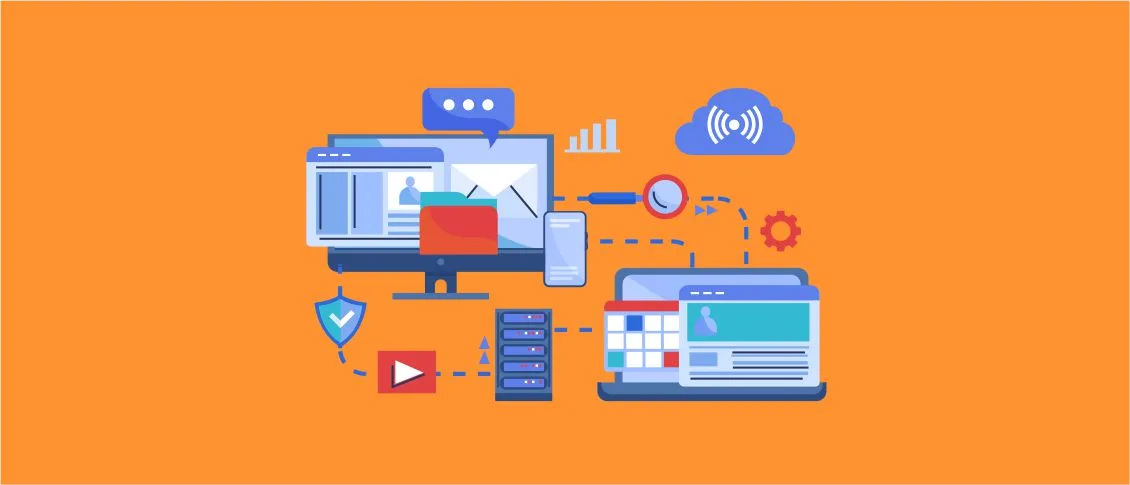- Overview
- The .NET Framework Version History
- Next Generation Windows Services (NGWS)
- .NET Framework
- .NET Framework 1.0 (2002)
- .NET Framework 1.1 (2003)
- .NET Framework 2.0 (2005)
- .NET Framework 3.0 (2006)
- .NET Framework 3.5 (2007)
- .NET Framework 4.0 (2010)
- .NET Framework 4.5 (2012)
- .NET Framework 4.6 (2015)
- .NET Framework 4.7 (2017)
- .NET Framework 4.8 (2019)
- .NET Core
- .NET Core 1.0 (2016)
- .NET Core 1.1 (2016)
- .NET Core 2.0 (2017)
- .NET Core 2.1 (2018)
- .NET Core 2.2 (2018)
- .NET Core 3.0 (2019)
- .NET Core 3.1 (2019)
- .NET 5
- .NET 6
- .NET 7
- .NET 8
- .NET Standard
- .NET Latest Version - 8.0.4
Overview
.NET is a popular developer platform made up of tools, programming languages, and libraries for building various types of applications. Over the years, .NET has evolved significantly, resulting in multiple versions with differing features and capabilities.
All .NET versions contain a Common Language Runtime (CLR) environment, base class libraries, and other managed libraries. This article describes the key features of .NET depending on the version.
To make sure that your software is capable of handling your current business needs, you need to keep a constant eye on its technical health. Technology has an unfortunate tendency to become obsolete, and the solutions built on top of it lose their capabilities and begin to take a toll.
If you have a solution created using .NET a few years ago, or if you are reviewing this technology for software development, check out this article.
The .NET Framework Version History
To make sure that your software is capable of handling your current business needs, you need to keep a constant eye on its technical health. Technology has an unfortunate tendency to become obsolete, and the solutions built on top of it lose their capabilities and begin to take a toll.
The .NET version history began with a concept called Next Generation Windows Services (NGWS), which Microsoft announced in the late 1990s. After realizing the need for a more versatile and cross-platform solution, Microsoft made the .NET Core release in 2016. And in 2020, Microsoft unified the .NET ecosystem with the release of .NET 5, combining .NET Core, .NET Framework, and Xamarin into a single platform known simply as .NET.
The first step to running your application efficiently is to verify the Dotnet version you have installed because this helps in ascertaining the application compatibility and unlocking the array of capabilities inherent in Microsoft’s development environment.
Next Generation Windows Services (NGWS)
The .NET Framework history began with a vision called the Next Generation Windows Services (NGWS), which Microsoft announced in the late 1990s. NGWS aimed to create a new platform for developing applications that could seamlessly integrate with the web. This vision materialized into the .NET Framework, launched in 2002, which revolutionized software development with its robust runtime environment, extensive class libraries, and support for multiple programming languages.
.NET Framework
The .NET Framework is a comprehensive and consistent programming model developed by Microsoft, primarily for building Windows applications. It provides a controlled environment for developing and running applications, with support for web services, desktop applications, and more.
Over the years, the .NET Framework evolved, adding new features and capabilities, but it remained largely Windows-centric.
.NET Framework 1.0 (2002)
The first .NET release laid the foundation with the Common Language Runtime (CLR), base class libraries, and ASP.NET for web applications.
Main Changes:
- Introduction of CLR
- Base class libraries
- ASP.NET for web applications
- Windows Forms for desktop applications
.NET Framework 1.1 (2003)
Enhanced version with better support for web services and mobile applications, alongside new language features.
Main Changes:
- Improved ASP.NET
- Support for mobile web applications
- Additional OOP features
- Built-in support for ODBC and Oracle databases
.NET Framework 2.0 (2005)
A major update introducing generics, anonymous methods, and partial classes, boosting development productivity and performance.
Main Changes:
- Generics
- Anonymous methods
- Partial classes
- Improved ADO.NET for data access
.NET Framework 3.0 (2006)
Expanded the .NET ecosystem with new frameworks for building modern applications.
Main Changes:
- Windows Presentation Foundation (WPF)
- Windows Communication Foundation (WCF)
- Windows Workflow Foundation (WF)
- Windows CardSpace
.NET Framework 3.5 (2007)
Introduced LINQ and integrated ASP.NET AJAX, enhancing existing frameworks and adding new language features.
Main Changes:
- Language Integrated Query (LINQ)
- ASP.NET AJAX
- Improved WPF, WCF, and WF
- New language features in C# 3.0 and VB.NET 9.0
.NET Framework 4.0 (2010)
Significant update featuring the Managed Extensibility Framework (MEF), dynamic language runtime, and parallel computing improvements.
Main Changes:
- Managed Extensibility Framework (MEF)
- Dynamic Language Runtime (DLR)
- Parallel LINQ (PLINQ) and Task Parallel Library (TPL)
- Improved interoperability with COM
.NET Framework 4.5 (2012)
Focused on asynchronous programming with the introduction of async and await keywords, plus performance and scalability improvements.
Main Changes:
- Async and await keywords
- Improved performance and scalability
- Enhanced support for web and cloud applications
- Better support for parallel and asynchronous operations
.NET Framework 4.6 (2015)
Introduced the RyuJIT compiler, improved cryptography support, and additional APIs for better productivity and security.
Main Changes:
- RyuJIT compiler
- Enhanced cryptography support
- New APIs for improved productivity
- High DPI support for Windows Forms
.NET Framework 4.7 (2017)
Improvements in high DPI support, touch support for WPF, and updates to cryptography APIs.
Main Changes:
- High DPI improvements
- Touch support for WPF applications
- Updated cryptography APIs
- Enhanced accessibility features
.NET Framework 4.8 (2019)
The final version of the .NET Framework, including enhancements to high DPI support, accessibility improvements, and security updates.
Main Changes:
- Improved high DPI support
- Accessibility enhancements
- Security updates
- Enhanced performance and reliability
.NET Core
Recognizing the need for a more versatile and cross-platform solution, Microsoft introduced .NET Core in 2016. This open-source, cross-platform framework brought the power of .NET to Linux, macOS, and Windows, enabling developers to build high-performance applications that could run anywhere. .NET Core rapidly gained popularity due to its modular architecture, performance enhancements, and active community support.
In 2020, Microsoft unified the .NET ecosystem with the release of .NET 5, merging .NET Core, .NET Framework, and Xamarin into a single platform simply known as .NET. This new era of .NET aimed to provide a consistent developer experience, enhanced productivity, and cutting-edge performance across all types of applications, whether web, desktop, mobile, cloud, or IoT. The ongoing evolution of .NET, with versions 6, 7, and 8, continues to build on this foundation, driving innovation and empowering developers to create modern, scalable, and high-performance solutions.
.NET Core 1.0 (2016)
The initial release of .NET Core provided a modular and high-performance framework for building modern, scalable applications. It included ASP.NET Core for web development and Entity Framework Core for data access.
Main Changes:
- Cross-platform support (Windows, macOS, Linux)
- Modular architecture
- ASP.NET Core for web applications
- Entity Framework Core for data access
- Command-line interface (CLI)
.NET Core 1.1 (2016)
An incremental update that brought several performance improvements and additional APIs.
Main Changes:
- Performance enhancements
- Additional APIs
- Improved compatibility with .NET Framework libraries
.NET Core 2.0 (2017)
A significant update that expanded the API surface and improved compatibility with .NET Standard 2.0, making it easier to share code across different .NET implementations.
Main Changes:
- .NET Standard 2.0 support
- Expanded API surface
- Simplified project files
- Performance improvements
.NET Core 2.1 (2018)
Focused on enhancing performance, adding new tools, and improving the development experience.
Main Changes:
- Introduction of global tools
- Support for SignalR for real-time web applications
- HTTP Client performance improvements
- Span<T> for memory-efficient programming
.NET Core 2.2 (2018)
A minor update that included several enhancements and updates to existing features.
Main Changes:
- Further performance improvements
- Enhancements to ASP.NET Core
- Improved diagnostics and logging
.NET Core 3.0 (2019)
A major release that added support for Windows desktop applications (WinForms and WPF), new C# 8.0 features, and significant performance enhancements.
Main Changes:
- Support for WinForms and WPF
- C# 8.0 features
- Entity Framework Core 3.0
- Improved performance and garbage collection
- .NET Core Windows Forms Designer (preview)
.NET Core 3.1 (2019)
A Long-Term Support (LTS) release that built on the improvements of .NET Core 3.0, focusing on stability and performance.
Main Changes:
- LTS designation
- Blazor for building interactive web UIs
- Improved Windows Forms and WPF
- Performance enhancements and bug fixes
.NET 5
Microsoft’s .NET 5 release date was November 10, 2020. The company made significant changes in the .NET 5 framework compared to its successors. Since then, there have been several releases every year.
Main Changes:
- C# updates
- F# updates
- Visual Basic updates
- System.Text.Json new features
- Single file apps
- App trimming
- Windows Arm64 and Arm64 intrinsics
- Tooling support for dump debugging
- The runtime libraries are 80% annotated for nullable reference types
- Performance improvements
.NET 6
.NET 6 is part of the .NET family, succeeding .NET Core 3.1 and .NET 5. As a cross-platform framework, it supports application development and deployment on Windows, macOS and Linux.
Main Changes:
- C# 10 Language Update
- F# 6 and Visual Basic
- HTTP/3 Support
- Cloud Diagnostics
- Package Validation Tooling
- Enhanced Security
- SDK Workloads
.NET 7
In .NET 7, Microsoft has enhanced its features such as:
- Native AOT,
- OSR,
- PGO,
- centralized package manager,
- expression library, and others.
.NET 8
The .NET current version, which is .NET 8, was released on November 14, 2023.
The .NET 8 runtime includes:
- improvements to performance,
- garbage collection, and the core and extension libraries.
- new globalization mode for mobile apps and new source generators for COM interop and configuration binding.
.NET Standard
.NET Standard is a formal specification of .NET APIs that are intended to be available across all .NET implementations. Its primary purpose is to establish greater uniformity in the .NET ecosystem, allowing developers to create libraries that work across various .NET platforms without modification.
How .NET Standard Connects to the .NET Family:
- .NET Framework: Older versions of .NET can use .NET Standard libraries if they support the required .NET Standard version.
- .NET Core: Fully supports .NET Standard, enabling cross-platform compatibility.
- Xamarin: Uses .NET Standard to share code across mobile applications for iOS and Android.
- .NET 5 and Beyond: .NET 5 and later unify the .NET platform, and they fully support .NET Standard, ensuring backward compatibility with existing .NET Standard libraries.
.NET Standard plays a crucial role in the .NET ecosystem by providing a common API specification that all .NET platforms adhere to. This allows developers to create reusable libraries that work across different .NET environments, facilitating code sharing and reducing the effort required to maintain compatibility. With the advent of the unified .NET platform, .NET Standard continues to ensure that the broad range of applications and libraries can work seamlessly together.
.NET Latest Version – 8.0.4
What is the latest version of .NET? Tracking the .NET version support status and lifecycle is important for application support and upgrade planning. .NET 8.0.4. The .NET 8.0.4 and .NET SDK 8.0.204 releases are available for download.
- Includes the .NET runtime environment and the ASP.NET Core runtime environment.
- For hosting standalone applications on Windows servers. Includes the ASP.NET Core module for IIS and can be installed standalone on servers without installing the .NET Runtime.
The .NET SDK includes a corresponding updated version of the .NET Runtime. You do not need to download the Runtime or ASP.NET Core packages when installing the SDK.
You can significantly reduce the costs associated with operations, maintenance and support by taking advantage of the newest .NET versions.










